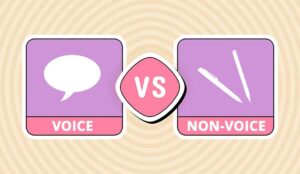In this article, Clinton Jordan, The Motivational Vocal Coach, explains how important it is for agents to be aware of their tone of voice.
Clinton also outlines how agents can use this knowledge as a tool to help improve their conversations, so they come across as more natural, genuine and effective.
What Is Tone of Voice?
Tone of voice refers to the way someone speaks and is made up of several factors, including pace and pitch – all of which play a part in determining how a message is conveyed.
For example, an agent can be saying the exact same sentence to a customer, but the tone in which they say it can convey a multitude of meanings.
Tone of Voice Is a Powerful Tool
Tone of voice (or melodic construct used in speech) is the melody used in our conversation and is a powerful yet subtle way of changing a conversation.
If a person is unaware of the use of melody in their voice, they can inadvertently come across as aggressive, weak, obscure, or passive (to name a few).
Changes in melodic tone used in dialogue can steer a conversation down a positive or negative path.
Think of the voice as an instrument – the music becomes more interesting when a series of notes are playing alongside each other. Speaking (talking in pitch) is musical.
For example, if the agent is speaking in a monotone (i.e. on a single note), a customer could miss valuable information – because the agent hasn’t expressed enough variety of melodic notes to keep them engaged in what’s being said.
Equally, it’s easy for the agent to overcomplicate things and make it hard for a customer to keep up. It helps to think of the voice as an instrument – the music becomes more interesting when a series of notes are playing alongside each other. Speaking (talking in pitch) is musical.
Tone of Voice Can Be Taught
Tone of voice can be taught. However, most people are not working congruently with their body and so don’t know what to do to utilize the tools at their disposal. These include the four components to activate the voice.
The Four Components to Activate the Voice
- Actuator – Air production from the diaphragm/lungs, responsible for breathing calmly.
- Vibrators – Responsible for your vocal folds exploring pitch, timing and dynamics.
- Resonators – Responsible for the depth of your sound, i.e. strong thick voice or soft gentle voice.
- Articulators – Responsible for pronunciation, punctuation being understood.
It’s important therefore that agents find balance and use a tone that allows customers to tune in to what they’re saying. It’s like seasoning food: doing it simply can be fantastic, but overcomplicating it can lead to an over-seasoned dish.
Monitoring Tone of Voice

Traditionally, agents may have been coached in their tone of voice as part of call listening and quality monitoring – based on a sample of call recordings.
More recently, however, artificial intelligence has allowed for smarter, real-time feedback and learnings to be available to agents, as Nigel Dunn, Managing Director, EMEA North from Jabra explains:
“Engage AI is unique sentiment analysis software for improving the customer and agent experience in contact centres. Using powerful artificial intelligence technology to analyse tone of voice in real time, Engage AI enables agents and their supervisors to receive insights on the sentiment and engagement levels during a call.
“It also provides an instant measurement of the customer experience and live feedback and coaching on how to manage the given situation. This helps to support personal development and wellbeing for agents, bringing them closer to their supervisors in an era of remote working.”
How to Use Emotion in Your Voice

The advantage in a contact centre is that using a workflow or script can help agents be more prepared for the conversations they are going to be having – compared to the complete improvisation of a natural conversation with a friend or family member.
Even so, agents may not always be prepared for how the customer reacts. In such scenarios, it helps for agents to think of emotion as energy and motion. If they are conscious of the energy they bring to every call, they can better control the outcome of the call.
For example, it’s important for agents to understand when to introduce softness to their voice (dynamic range) and when they need to change it up to cut through the conversation and get the customer’s attention (adjusting the timbre-shape of sound).
Agents can also actively switch their tone of voice and subtly prompt the customer to do the same. Remember, conversation is like a dance, and a dance needs music for people to join in.
How to Improve Your Tone of Voice
1. Lean Into the Language of Love
The language of love is a warmer sound. It can help to think of it like a mother talking to her child, changing the depth of the sound to make her voice sound more comforting (resonance).
In a call centre environment, an agent adopting a warmer tone encourages the customer to soften their voice too.
This can help an agent to come across as more maternal and sympathetic in their tone of voice, as they softly say, “Oh, let’s look into your file. Ah, I can see there is a…”
For some great suggestions on the language to use, read our article: Positive Language for Customer Service Conversations
2. Avoid a Sharp and Penetrating Nasal Sound
There is clear difference in the tonality of sympathy and love when compared to going more nasal, making the voice sharp and penetrating.
An agent using this tone risks sounding as though they are interrogating the customer and pushing the conversation towards a negative outcome.
A great way to remember this is to think that teeth and high sibilance sounding words create musical images of reflective sharp objects like knives. Intrusive, penetrative, and dividing. Make sure you use these tools in context to your conversation.
3. The Power of Pace – Slow Your Pace When Explaining Something
Agents should also be conscious of the use of tempo in a conversation.
For example, an agent could consciously slow down their voice to explain something, to give the customer better opportunity to understand what’s being said.
5. Think About the Rhythm of the Call
Agents should also be aware of the rhythm – the mixture of sound and silence – in a conversation. For example, with shorter gaps of silence, the agent can create an active pace – helping to move the call forward towards a conclusion.
It’s important for the agent to set the right tempo from the very beginning of the call.
It’s equally important for the agent to set the right tempo from the very beginning of the call too. The customer shouldn’t be faced with a tempo that’s too fast or too slow from the minute they engage in the conversation.
Instead, agents should practise finding a middle ground on tempo to suit most callers, and then be prepared to adjust accordingly.
If the customer comes to the call with a fast-paced tempo, it’s critical the agent does not match it and instead sets a more calming pace to try and regain some control.
To learn more about how to develop great call control skills, read our article: How to Improve Call Control Skills
6. Play With Pitch and Melody to Keep the Customer Engaged
Agents also need to consider the pitch and melody of the call, as varying the melody of the conversation can help customers stay engaged.
The key to finding a melodic engagement that works is for an agent to start paying more attention to the way they speak, so they can find and feel their way through the conversation, complementing the customer’s melody and finding balance.
A Note of Caution:
If an agent is constantly raising the pitch of their voice at the end of every sentence, it can suggest a cliff-hanger and that there’s more information to follow.
Used sparingly, this technique can help keep the conversation moving, but in quick succession, it can make customers feel as though they are climbing a cliff and the conversation can quickly nose-dive.
7. Practise Sounding Sincere in the Mirror
Practice makes perfect!
It can really help agents to practise their welcome verse of “Hello, I’m Adam…” in the mirror, as this allows them to experiment and find a tone of voice that genuinely sounds sincere, as customers can easily detect when you aren’t.
It’s about finding a balance of having enough resonance in your voice that someone doesn’t feel threatened, and enough warmth to make them feel comfortable – bringing a sense of calm and hospitality to the call.
Examples of Tone of Voice in Action
You can see an example of the contrast between the warmer ‘language of love’ and sharp ‘nasal tone’ in the short video clip from Clinton Jordan below:
Thanks to Clinton Jordan, The Motivational Vocal Coach, for this great article.
For more information on using tone of voice and other great call-handling skills, read these articles next:
- How to Use Vocal Pace, Tone and Pitch on the Phone
- 5 Simple Tips for Improving Tone of Voice in Customer Service
- Customer Service Language: Changing the Language of Your Contact Centre
- Customer Service Skills: How to Improve Empathy, Active Listening and Knowledge
Author: Clinton Jordan
Reviewed by: Megan Jones
Published On: 16th Jan 2023 - Last modified: 30th Apr 2024
Read more about - Skills, Clinton Jordan, Jabra, Language, Soft Skills




































